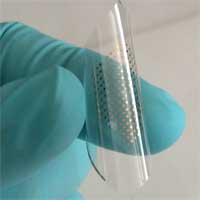Showing Spotlights 193 - 200 of 200 in category All (newest first):
 It wasn't market forces that landed a man on the moon; and It wasn't market forces that led France to build a nuclear energy infrastructure that now enables it to generate some 75% of its entire energy needs from nuclear power (just an example of what energy policy can do; let's not get into a discussion here of nuclear energy, though). But somehow, the leading political and industrial forces in the United States - together with China the largest emitter of greenhouse gases on the planet - think that a task so fundamental and massive as fighting global warming and environmental pollution should mostly be left 'to the market'. Unfortunately, it's just a matter of economic reality that 'the market' will not invest in new energy technologies on a large scale until existing ways of producing energy become more expensive than producing alternative energies - which at the moment they aren't. As is the case with almost all emerging technologies, government initially lends a helping hand before the technology becomes a viable commercial proposition and the market takes over (remember how the Internet got created?). In the case of future clean energy technologies, it appears that this 'helping hand' needs to be massive and swift. It's not so much that clean/green tech wouldn't develop over time on its own. But it's against the backdrop of accelerating global warming that it becomes a top priority that requires massive public resources.
It wasn't market forces that landed a man on the moon; and It wasn't market forces that led France to build a nuclear energy infrastructure that now enables it to generate some 75% of its entire energy needs from nuclear power (just an example of what energy policy can do; let's not get into a discussion here of nuclear energy, though). But somehow, the leading political and industrial forces in the United States - together with China the largest emitter of greenhouse gases on the planet - think that a task so fundamental and massive as fighting global warming and environmental pollution should mostly be left 'to the market'. Unfortunately, it's just a matter of economic reality that 'the market' will not invest in new energy technologies on a large scale until existing ways of producing energy become more expensive than producing alternative energies - which at the moment they aren't. As is the case with almost all emerging technologies, government initially lends a helping hand before the technology becomes a viable commercial proposition and the market takes over (remember how the Internet got created?). In the case of future clean energy technologies, it appears that this 'helping hand' needs to be massive and swift. It's not so much that clean/green tech wouldn't develop over time on its own. But it's against the backdrop of accelerating global warming that it becomes a top priority that requires massive public resources.
Apr 30th, 2008
 The race is on to develop the next generation of nanotechnology-enabled electrochemical energy storage devices, also knows as batteries. Lithium of course has long been recognized as an ideal material for energy storage due to its light weight and high electrochemical energy potential, as witnessed by the ubiquitous use of Li-ion batteries. There still seems to be considerable potential to further improve the performance characteristics of these Li-ion batteries. There have been many design approaches to creating lithium ion batteries but they usually share common features: The positive electrode is typically a lithium metal oxide, with various metals used such as cobalt, nickel, and manganese. The negative electrode is typically a carbon compound or natural or synthetic graphite. Researchers in Germany have now demonstrated a simple route for transforming cheap commercial carbon nanotubes into highly efficient carbon for electrochemical energy storage applications. When tested as electrode materials for lithium batteries, this composite material exhibits excellent performance over long test cycles.
The race is on to develop the next generation of nanotechnology-enabled electrochemical energy storage devices, also knows as batteries. Lithium of course has long been recognized as an ideal material for energy storage due to its light weight and high electrochemical energy potential, as witnessed by the ubiquitous use of Li-ion batteries. There still seems to be considerable potential to further improve the performance characteristics of these Li-ion batteries. There have been many design approaches to creating lithium ion batteries but they usually share common features: The positive electrode is typically a lithium metal oxide, with various metals used such as cobalt, nickel, and manganese. The negative electrode is typically a carbon compound or natural or synthetic graphite. Researchers in Germany have now demonstrated a simple route for transforming cheap commercial carbon nanotubes into highly efficient carbon for electrochemical energy storage applications. When tested as electrode materials for lithium batteries, this composite material exhibits excellent performance over long test cycles.
Apr 29th, 2008
 Two of the major challenges of our modern, mobile society are the shrinking of available fossil energy resources on one hand and climate change associated with global warming on the other. Continuing population growth multiplied by the increase in consumption and living standards, especially in developing countries, will require more and more oil, coal and natural gas to 'power' humanity. Notwithstanding efforts like the Kyoto Protocol - which wasn't signed by the two major CO2 polluters China and the U.S. - an ever increasing rate of fossil fuel usage means that the increasing emission of CO2 is likely to cause an acceleration of the climate change that is in progress already. Transportation, in particular passenger cars, is one of the areas where new technology could lead to environmental beneficial change. Never mind that GM is still selling 15-20,000 Hummers a year, or that Tata is planning to sell millions of its new Nano car. One of the much touted technological solutions is to substitute fossil hydrocarbon based energy with the energy from carbon-free sources like the sun, nuclear energy, or the hot interior of the Earth and use hydrogen as an energy carrier. Hydrogen can be produced from water using energy from carbon-free sources and can serve as fuel in fuel cells to generate electricity, either stationary or on board of vehicles. Considerable research efforts are going into the evaluation of various nanostructures, such as carbon nanotubes, to find the most suitable hydrogen storage materials.
Two of the major challenges of our modern, mobile society are the shrinking of available fossil energy resources on one hand and climate change associated with global warming on the other. Continuing population growth multiplied by the increase in consumption and living standards, especially in developing countries, will require more and more oil, coal and natural gas to 'power' humanity. Notwithstanding efforts like the Kyoto Protocol - which wasn't signed by the two major CO2 polluters China and the U.S. - an ever increasing rate of fossil fuel usage means that the increasing emission of CO2 is likely to cause an acceleration of the climate change that is in progress already. Transportation, in particular passenger cars, is one of the areas where new technology could lead to environmental beneficial change. Never mind that GM is still selling 15-20,000 Hummers a year, or that Tata is planning to sell millions of its new Nano car. One of the much touted technological solutions is to substitute fossil hydrocarbon based energy with the energy from carbon-free sources like the sun, nuclear energy, or the hot interior of the Earth and use hydrogen as an energy carrier. Hydrogen can be produced from water using energy from carbon-free sources and can serve as fuel in fuel cells to generate electricity, either stationary or on board of vehicles. Considerable research efforts are going into the evaluation of various nanostructures, such as carbon nanotubes, to find the most suitable hydrogen storage materials.
Jan 21st, 2008
 The problem with most current hydrogen sensor designs is that they are built on rigid substrates, which cannot be bent, and therefore, their applications might be limited due to the mechanical rigidity. In addition, they use expensive, pure palladium. A new type of sensors is bendy and use single-walled carbon nanotubes to improve efficiency and reduce cost. In the example of the space shuttle, laminating a dense array of flexible sensors on the whole surface of a pipe can detect any leakage of hydrogen prior to diffusion and alert control units to remedy the malfunction.
The problem with most current hydrogen sensor designs is that they are built on rigid substrates, which cannot be bent, and therefore, their applications might be limited due to the mechanical rigidity. In addition, they use expensive, pure palladium. A new type of sensors is bendy and use single-walled carbon nanotubes to improve efficiency and reduce cost. In the example of the space shuttle, laminating a dense array of flexible sensors on the whole surface of a pipe can detect any leakage of hydrogen prior to diffusion and alert control units to remedy the malfunction.
Oct 11th, 2007
 Back in January, when the U.S. president announced his hydrogen fuel initiative and proposed to spend a total of $1.7 billion over the next five years to develop hydrogen-powered fuel cells, hydrogen infrastructure and advanced automotive technologies, he said that it will be practical and cost-effective for large numbers of Americans to choose to use clean, hydrogen fuel cell vehicles by 2020. According to the U.S. Department of Energy's (DOE) Hydrogen Program, the government's goal is to achieve "technology readiness" by around 2015 in order to allow industry to make decisions on commercialization by then. That's only eight years to go. Given where the technology is today, this goal seems very ambitious, to say the least. Nanotechnology could help speed up the journey to the hydrogen society, but it will take some sensational breakthroughs on the way. The three key areas for the vehicles (we will not touch on the infrastructure issues here) are clean - the emphasis is on clean - hydrogen production, hydrogen storage, and the fuel cell itself. We'll take a look at how nanotechnology will play a role in these areas.
Back in January, when the U.S. president announced his hydrogen fuel initiative and proposed to spend a total of $1.7 billion over the next five years to develop hydrogen-powered fuel cells, hydrogen infrastructure and advanced automotive technologies, he said that it will be practical and cost-effective for large numbers of Americans to choose to use clean, hydrogen fuel cell vehicles by 2020. According to the U.S. Department of Energy's (DOE) Hydrogen Program, the government's goal is to achieve "technology readiness" by around 2015 in order to allow industry to make decisions on commercialization by then. That's only eight years to go. Given where the technology is today, this goal seems very ambitious, to say the least. Nanotechnology could help speed up the journey to the hydrogen society, but it will take some sensational breakthroughs on the way. The three key areas for the vehicles (we will not touch on the infrastructure issues here) are clean - the emphasis is on clean - hydrogen production, hydrogen storage, and the fuel cell itself. We'll take a look at how nanotechnology will play a role in these areas.
Jul 19th, 2007
 Fuel cells are electrochemical energy conversion devices for the direct conversion of the chemical energy of a fuel into electricity. They are among the key enabling technologies for the transition to a hydrogen-based economy. Of several different types of fuel cells under development today, polymer electrolyte fuel cells (PEFCs) have been recognized as a potential future power source for zero emission vehicles. However, to become commercially viable, PEFCs have to overcome the barrier of high catalyst cost caused by the exclusive use of platinum and platinum-based catalysts in the fuel-cell electrodes. Researchers at Los Alamos National Laboratory now demonstrate a new class of low cost (non-precious metal)/(heteroatomic polymer) nanocomposite catalysts for the PEFC cathode, capable of combining high oxygen-reduction activity with good performance durability. The results of their study show that heteroatomic polymers can be used not only to stabilize the nonprecious metal in the acidic environment of the PEFC cathode but also to generate active sites for oxygen reduction reaction.
Fuel cells are electrochemical energy conversion devices for the direct conversion of the chemical energy of a fuel into electricity. They are among the key enabling technologies for the transition to a hydrogen-based economy. Of several different types of fuel cells under development today, polymer electrolyte fuel cells (PEFCs) have been recognized as a potential future power source for zero emission vehicles. However, to become commercially viable, PEFCs have to overcome the barrier of high catalyst cost caused by the exclusive use of platinum and platinum-based catalysts in the fuel-cell electrodes. Researchers at Los Alamos National Laboratory now demonstrate a new class of low cost (non-precious metal)/(heteroatomic polymer) nanocomposite catalysts for the PEFC cathode, capable of combining high oxygen-reduction activity with good performance durability. The results of their study show that heteroatomic polymers can be used not only to stabilize the nonprecious metal in the acidic environment of the PEFC cathode but also to generate active sites for oxygen reduction reaction.
Oct 6th, 2006
 Greatly expanding on previously reported work on platinum nanostructures, researchers at Sandia National Laboratories just released a new paper describing a range of novel platinum nanostructures with potential applications in fuel and solar cells as well as nanotags in biomedicine.
Greatly expanding on previously reported work on platinum nanostructures, researchers at Sandia National Laboratories just released a new paper describing a range of novel platinum nanostructures with potential applications in fuel and solar cells as well as nanotags in biomedicine.
Mar 31st, 2006
 In the future hydrogen economy, hydrogen (H2) sensors will be a critical component for safety and widely needed. For example, H2 sensors will detect leaks from hydrogen-powered cars and fueling stations long before the gas becomes an explosive hazard.
In the future hydrogen economy, hydrogen (H2) sensors will be a critical component for safety and widely needed. For example, H2 sensors will detect leaks from hydrogen-powered cars and fueling stations long before the gas becomes an explosive hazard.
Mar 15th, 2006
 It wasn't market forces that landed a man on the moon; and It wasn't market forces that led France to build a nuclear energy infrastructure that now enables it to generate some 75% of its entire energy needs from nuclear power (just an example of what energy policy can do; let's not get into a discussion here of nuclear energy, though). But somehow, the leading political and industrial forces in the United States - together with China the largest emitter of greenhouse gases on the planet - think that a task so fundamental and massive as fighting global warming and environmental pollution should mostly be left 'to the market'. Unfortunately, it's just a matter of economic reality that 'the market' will not invest in new energy technologies on a large scale until existing ways of producing energy become more expensive than producing alternative energies - which at the moment they aren't. As is the case with almost all emerging technologies, government initially lends a helping hand before the technology becomes a viable commercial proposition and the market takes over (remember how the Internet got created?). In the case of future clean energy technologies, it appears that this 'helping hand' needs to be massive and swift. It's not so much that clean/green tech wouldn't develop over time on its own. But it's against the backdrop of accelerating global warming that it becomes a top priority that requires massive public resources.
It wasn't market forces that landed a man on the moon; and It wasn't market forces that led France to build a nuclear energy infrastructure that now enables it to generate some 75% of its entire energy needs from nuclear power (just an example of what energy policy can do; let's not get into a discussion here of nuclear energy, though). But somehow, the leading political and industrial forces in the United States - together with China the largest emitter of greenhouse gases on the planet - think that a task so fundamental and massive as fighting global warming and environmental pollution should mostly be left 'to the market'. Unfortunately, it's just a matter of economic reality that 'the market' will not invest in new energy technologies on a large scale until existing ways of producing energy become more expensive than producing alternative energies - which at the moment they aren't. As is the case with almost all emerging technologies, government initially lends a helping hand before the technology becomes a viable commercial proposition and the market takes over (remember how the Internet got created?). In the case of future clean energy technologies, it appears that this 'helping hand' needs to be massive and swift. It's not so much that clean/green tech wouldn't develop over time on its own. But it's against the backdrop of accelerating global warming that it becomes a top priority that requires massive public resources.
 Subscribe to our Nanotechnology Spotlight feed
Subscribe to our Nanotechnology Spotlight feed


